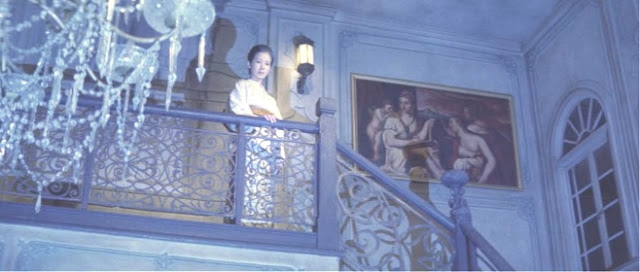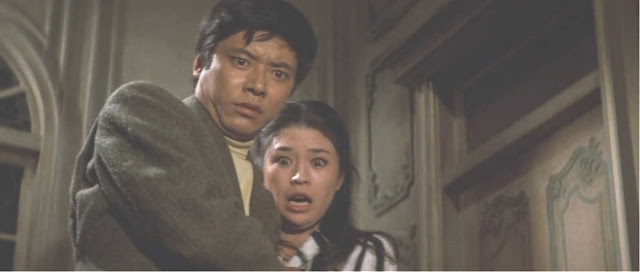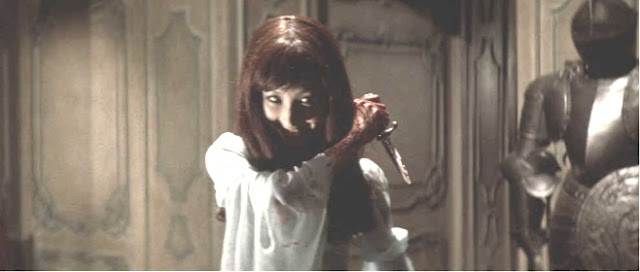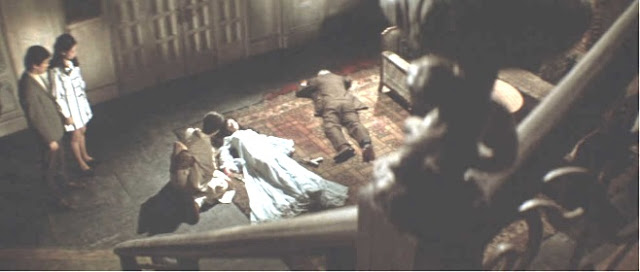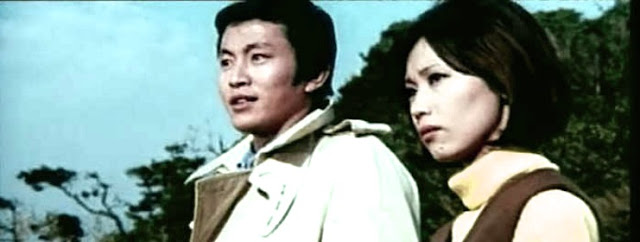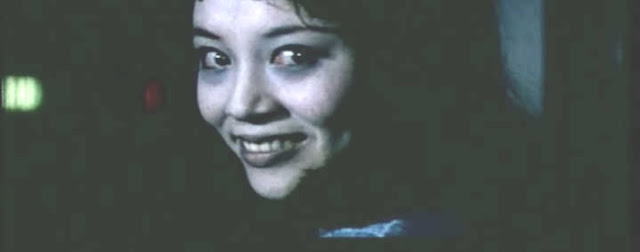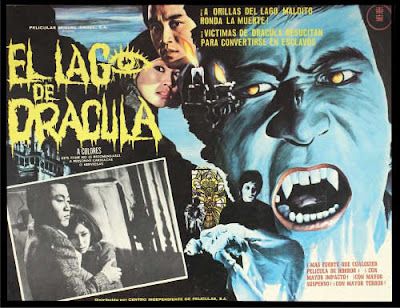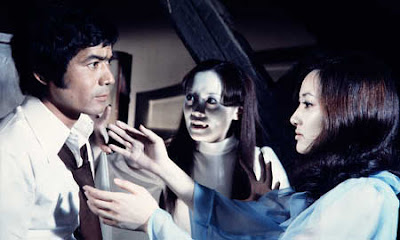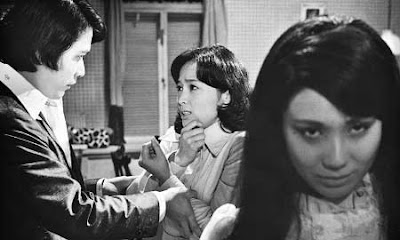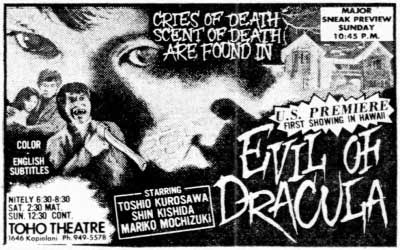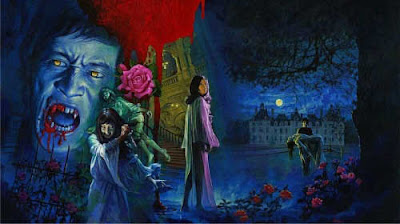The Bloodthirsty Trilogy
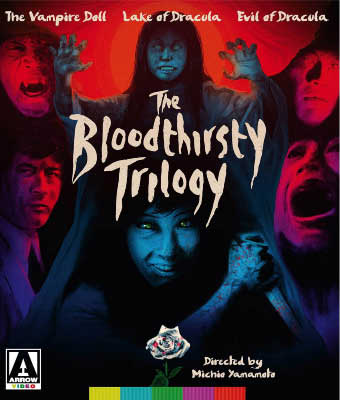
The Vampire Doll (1970) - 8.0
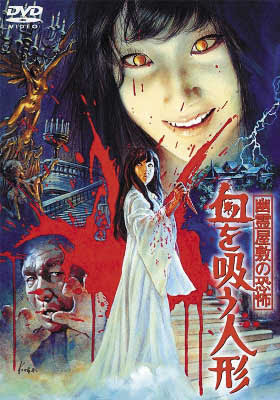
This is the first in what became known at least in the West as the Bloodthirsty
Trilogy about vampires directed by Michio Yamamoto. The other two are Lake
of Dracula in 1971 and Evil of Dracula in 1974. It seems an odd and unique
choice of subject matter. Vampires were not part of Japanese folklore as
were ghosts and Yokai which most Japanese horror focused on. But certainly,
the Japanese were aware of the vampire films from the West and were influenced
by them just as the Kaiju films were influenced by the giant monster films
in Hollywood. The first vampire film in Japan came not surprisingly from
Nobuo Nakagawa with Lady Vampire in 1959, a strange little film that doesn't
really track closely to the West's vampire characteristics - daylight does
not kill him and the full moon brings out his need for blood and a pretty
neck.
As far as I know there were no other Japanese vampire films between that
and these three. Nobuo went back to his ghost stories. So, one might wonder
what brought this on from Toho. I expect the success of the Hammer Dracula
series had something to do with it. But this one has no resemblance to the
Hammer films at all. It is closer to a Universal Dark House Tale in many
respects but one with a vampire. It is slowly told with lots of moody and
creepy aspects surrounding it like a tightening strangling snake. Beautifully
shot and framed and the fear from the couple feels very real. It is one of
those films that when watching you just want to tell them to leave and never
look back but of course they don't. There are a few jump scares and at the
end some gore but it is mainly just the dread that crawls up your back like
an insect that counts.
Late at night, Sagawa (Atsuo Nakamura) arrives in a taxi at the home where
his girlfriend Yuko (Yukiko Kobayashi) lives. It is an old gothic styled
home built a generation ago in the country far from where anyone can hear
your screams. Everything creaks and the wind makes chilling sounds. Upon
his arrival he is first attacked by the deaf mute servant for no reason.
An Igor type. Yuko's mother (Yôko Minakaze) gives him the tragic news
that Yuko died in an accident two weeks earlier. The actress playing the
mother gives a great performance by rarely changing expression but that calm
polite expression with the cold emotionless eyes would scare the hell out
of anyone. It is like looking at orbs of death. Sagawa spends the night and
goes to visit Yuko's grave the next day and sees Yuko. "Kill me, please kill
me". Instead, he embraces her.
His sister Keiko (Kayo Matsuo) becomes worried when her brother doesn't return
and asks her friend Hiroshi (Akira Nakao) to drive her to the house to find
out what happened. "He left days ago". But things just don't appear right
and so Hiroshi fakes the car not being able to start and they have to spend
the night. That might not have been a great idea. It turns into a Gothic
tale of mass murder in the past and a mother's obsessive love for her daughter.
Sometimes you just have to let go.
The Lake of Dracula
(1971) - 6.0
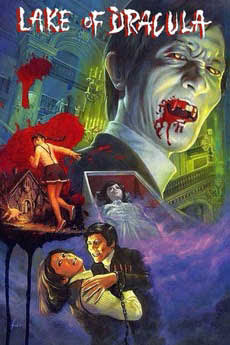
One thing I have learned about vampires is that you don't go hunting them
with no weapons or a crucifix and especially at night. Do people not know
this? Even in 1971. And when someone you know begins to act strangely, walk
about outside in the middle of the night, laugh manically and covers her
neck with sweaters, you might want to keep a very close eye on them. That
is why I check my girlfriend's neck before going to sleep every night. Because
you can never be too safe.
This is the second in the vampire trilogy from director Michio Yamamoto -
The Vampire Doll in 1970 and Evil of Dracula in 1974. I picked these up at
Kim's video store in NYC about 20 years ago and never got around to watching
them. So maybe it's time. The quality of this dvd was fairly bad with the
sound arriving about fifteen seconds before the visual. That is annoying
- I would hear a scream and nothing was going on till a bit later. Still,
this is a fairly effective, creepy horror film that for the first half is
a nifty woman alone in her house being terrified. Then the vampires show
up and so does her boyfriend.
It begins when Akiko is a five-year-old girl running after her dog
into a spooky house. She sees a dead woman at the piano playing and a hideous
man leering at her. An older man helps her out and over the years she has
pushed this experience deep into her subconscious. Eighteen years later she
has moved away from where that happened but still has a dog. She (Midori
Fujita) lives with her sister Natsuko (Sanae Emi) out in the isolated country
surrounded by forests and she has a doctor boyfriend (Chôei Takahashi).
A large box arrives at the corner store and her handy man opens it. A coffin?
And opens the coffin. Never a good idea. He soon has two bites on his neck
and tries to rape Akiko. Her dog turns up dead and her sister begins to act
oddly. The dream begins to resurface and a sense of unease slowly crawls
along as it begins to appear that a vampire is in town. And remembers her
from long ago. And wants her. Produced by Toho. These appear to be
out on blue ray now. Wish I could see those.
Evil of Dracula
(1974) - 7.0
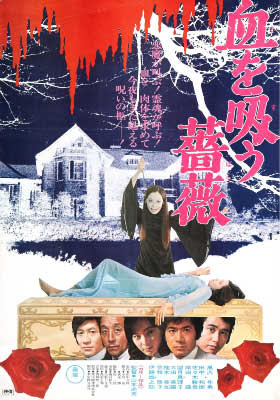
The third in the Bloodthirsty Trilogy from director Michio Yamamoto, all
dealing with vampires. This one more than the others seems to be influenced
by the vampire films of the West, in this case those produced in Europe with
the gore and a smidgeon of nudity and filmed in dark claustrophobic rooms
and hallways. Setting it in a school of nubile young women may give it that
flavor as well and reminded me of Argento's Suspiria. Something very sinister
is happening at this school and girls are disappearing. But no one seems
to notice or care except the new teacher, Shiraki (Toshio Kurosawa). The
Principle (Shin Kishida) of the school matter of factly tells him that his
recently deceased wife is in a coffin in the basement among the fine wines.
Shiraki appears startled but is reassured that this is a local custom in
hopes that the person comes back to life. Huh? That would have sent me home
on the next bus, but Shairaki shrugs as if it's no big deal and drinks more
brandy.
He commits a terrible faux pas though when he goes down to the basemen and
opens the coffin to look at the wife. I would be angry if that was my wife
and Shiraki apologizes - "I just wanted to see your dead wife". What he didn't
notice is that she had woken up and was looking hungry. Later he sees the
latest missing girl who looks very fetching in her blue negligee and blood
dripping down from two bites on the breast. He puts it down to a bad dream
until another girl also gets the two bites and is acting strange and turning
blue. Somehow this doesn't tip him off that vampires are about. And when
he finally does, he goes into stupid mode. Much of the second half of the
film is propelled by people acting idiotically.
Chasing vampires in the darkened forest is never a good idea and leaving
behind a student and telling her to lock the door while bedsitting a likely
vampire isn't either. You might think about sending her home to her
family. The Principle and his wife killing girls for their blood just strikes
me as bad for the bottom line. Those are paying students. But young blood.
So fresh. So innocent. Hard to argue. Ignoring the stupidity - what vampire
film doesn't have a big dose of that - this is fun and frantic and speeds
along like man running for a bus. All three of these are well shot - very
professional with a great eye for mise-en-scène and closed spaces.
For whatever reason he didn't go on to direct very much more - IMDB is all
screwed up on his filmography but this may have been his last film. All three
of the films have a touch of xenophobia - the first two with contact with
the West and this has an oddly related story that seems to blame vampires
in Japan as stemming from a foreigner who jumped ship hundreds of years ago
and turned into a vampire. It is post-War Japan and foreigners were often
the villains - even the Kaiju films can be laid at the feet of our use of
nuclear bombs.



